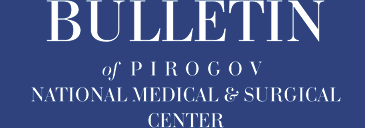Authors
Kraynyukov P.E.1, 2, Kim E.A.1, Gudantov R.B.1, Borisova A.V.1, Agafonov D.E.1, Kraynyukov E.P.3, 4
1 Central Military Clinical Hospital named after P.V. Mandryka, Moscow
2 Peoples’ Friendship University of Russia named after Patrice Lumumba, Moscow
3 413 Military Group, Volgograd
4 Institute of Public Health named after N.P. Grigorenko Volgograd State Medical University, Volgograd
Abstract
Justification: This work is the integration of safer and more effective drugs into clinical practice to optimize pain relief and reduce the risks associated with the use of traditional opioid analgesics.
Objective: to evaluate the effectiveness of pain relief in the early postoperative period using non-opioid analgesics (ibuprofen, tafalgin, nefopam) in patients with mine-blast wounds (MBW) accompanied by traumatic amputations of the limbs.
Methods: The study included 45 patients randomly assigned to three groups depending on the analgesic used: ibuprofen, tafalgin or nefopam.
Results: In all groups, there was a significant decrease in the need for additional postoperative analgesia, including opioid drugs. Nefopam provided the most pronounced analgesic effect, reducing pain intensity on the VAS scale more than ibuprofen and tafalgin. However, its use was accompanied by a higher frequency of side effects (dizziness, tachycardia, hypertension). Ibuprofen demonstrated an optimal combination of analgesic efficacy and safety, with a minimal frequency of side effects.
Conclusion: Nefopam has a pronounced analgesic effect in the early postoperative period in patients with MVR, but is associated with an increased frequency of side effects. Ibuprofen showed a high level of safety and sufficient efficacy, which makes it a preferred component of multimodal analgesia for this category of patients.
Keywords: nefopam, ibuprofen, tafalgin, pain in the early postoperative period, pain management.
References
1. Small C, Laycock H. Acute postoperative pain management. Journal of British Surgery. 2020; 107(2): e70-e80.
2. Liu SS, et al. Effects of perioperative analgesic technique on rate of recovery after colon surgery. ANESTHESIOLOGY-PHILADELPHIA THEN HAGERSTOWN. 1995; 83: 757-757.
3. Quinlan J, et al. No place for routine use of modified-release opioids in postoperative pain management. British Journal of Anaesthesia. 2022; 129(3): 290-293. doi: 10.1016/j.bja.2022.06.013.
4. Bennett M, Paice JA, Wallace M. Pain and opioids in cancer care: benefits, risks, and alternatives. American Society of Clinical Oncology Educational Book. 2017; 37: 705-713.
5. Fregoso G, et al. Transition from acute to chronic pain: evaluating risk for chronic postsurgical pain. Pain physician. 2019; 22(5): 479.
6. Neimark MI, et al. Multimodal analgesia in bariatric surgery. Regional Anesthesia and Acute Pain Management. 2016; 10(4): 254-261. doi: 10.17816/RA42819.
7. Chavez ML, DeKorte CJ. Valdecoxib: a review. Clinical therapeutics. 2003; 25(3): 817-851. doi: 10.1016/S0149-2918(03)80110-8.
8. Wahbi AA, et al. Spectrophotometric methods for the determination of Ibuprofen in tablets. Pakistan journal of pharmaceutical sciences. 2005; 18(4): 1-6.
9. Tripathi KD. Essentials of medical pharmacology. Jaypee Brothers medical publishers, 2018.
10. Tong D, Chung F, Wong TD. Satisfaction in Ambulatory Surgical Patients. Anesthesiology. 1997; 87(4): 856-64.
11. Mather GG, et al. Nefopam enantiomers: preclinical pharmacology/toxicology and pharmacokinetic characteristics in healthy subjects after intravenous administration. Chirality: The Pharmacological, Biological, and Chemical Consequences of Molecular Asymmetry. 2000; 12(3): 153-159. doi: 10.1002/(SICI)1520-636X(2000)12:3<153::AID-CHIR9>3.0.CO;2-V.
12. Durrieu G, et al. Overview of adverse reactions to nefopam: an analysis of the French Pharmacovigilance database. Fundamental & clinical pharmacology. 2007; 21(5): 555-558. doi: 10.1111/j.1472-8206.2007.00499.x.
13. Kraynyukov PE, Kim EA, Gudantov RB, et al. Modern principles of conservative drug pain relief in patients with traumatic limb amputations in the early postoperative period// Modern science: current problems of theory and practice. Series: Natural and technical sciences. 2025; 1: 215-225. (In Russ.)


